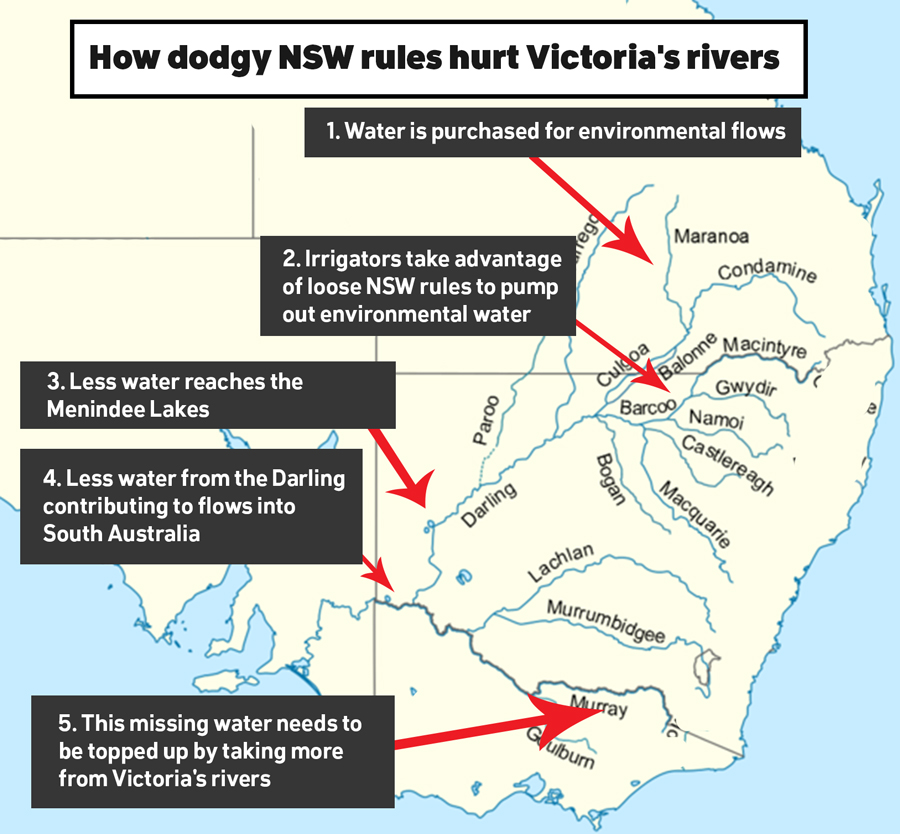Most Melburnians would know the Birrarung (Yarra) as a brown, often polluted waterway. But it was once a 'winter Kakadu' teeming with native wildlife.
At a time when the impacts of global warming are starting to bite and migratory bird numbers are declining, our challenge is to restore the health of our over exploited rivers. But instead of cooperating, governments and vested interested are fighting tooth and nail over the Basin Plan, with accusations of treachery, threats of walk-outs and insults flying in all directions.
[contentcards url=”http://www.abc.net.au/news/2017-06-05/murray-darling-basin-waterbirds-population-declining/8587720″ target=”_blank”]
The Murray-Darling Basin Plan was designed to repair our rivers and wetlands, and help the wildlife and communities that rely on them thrive into the future. But the Victorian and New South Wales governments want to cut the amount of water being returned to our rivers, while South Australia is pushing for more water. The final decision on whether any changes go ahead is made in the Senate.
The Senate has already rejected one attempt to cut the amount of water returned to the Darling and other rivers in the northern part of the Murray-Darling basin — Much to the disgust of the federal, NSW and Victorian governments.
This decision was made by the Greens and federal ALP with the support of the Nick Xenophon Team and Senator Hinch, and it is a major win for the Indigenous communities, threatened species of fish, migratory birds, downstream towns and farmers.
It will give our world renowned wetlands like the Macquarie Marshes the chance to recover and thrive.
But in view of all the allegations of water theft, meter tampering, disputed modelling and corruption in the northern basin, it wasn’t such a tough call for the Senate to make.

Allegations of water theft last year thrust the Murray-Darling plan back into the national spotlight.
Now the stakes have been raised — The Turnbull government is proposing another change. This time to cut the amount of water being returned in the southern part of the Murray-Darling basin.
This will mean less water for Victoria’s forests, wetlands and billabongs and the birds, fish, turtles and communities that rely on them.
It comes at the request of the Victorian and NSW governments. They have been lobbying for projects that they say will provide the same outcomes with less water. The trouble is, we don’t know if this is true.
The Wentworth Group of Concerned Scientists assessed all 37 of these projects, and concluded that only ONE was effective and ready to proceed. We should not cutting targets and placing our rivers at risk of further damage when there is that much uncertainty.
The other two missing pieces are; 1) the delivery of the additional 450GL (called ‘upwater’) that is an integral part of the plan and, 2) the strategy to enable this water to flow past the man made barriers (dams, weirs and locks) and actually get to the wetlands, billabongs and forests where it is needed.
The Victorian government has been progressively hardening its position on both these issues, and is actively backing big corporate irrigators. Water Minister Lisa Neville has told the Victorian Parliament ‘I can assure this house and I can assure northern Victorians that we are going to be continuing to advocate strongly to protect their water interests’.
The Senate is due to vote on the amendment in May, and they should be voting ‘no’. Changes to the Basin Plan should not be made until it can be shown the proposed projects actually do the job they are supposed to, there is a clear pathway to delivering the additional 450GL (‘upwater’) and it can get to the places it is needed most.
Only then will the plan be delivered ‘on time and in full’ as promised by all politicians from the Prime Minister down.
For too long, we have taken too much from the rivers that sustain us. It’s time the Victorian government to stop focussing on the short-term interests of corporate irrigators, and looked to the long-term gain that comes from restoring the flows to our rivers.